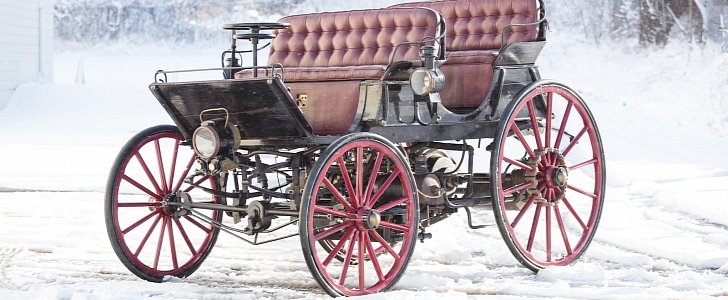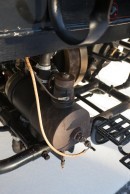The Toyota Prius and Chevrolet Volt may be the favorites of the eco-conscious crowd, but this thing right here predates them by more than a century. Yes, ladies and gents, this horseless carriage is one of the earliest known gas-electric hybrids ever made.
Scheduled to go under the hammer on March 10 at the Amelia Island sale in Florida, Bonhams estimates that $175,000 to $275,000 is what the top bidder will have to pay for the 1896 Armstrong Phaeton. Designed by a brilliant gentleman called Harry Dey at the end of the 19th century, the lone survivor of its breed is a truly pioneering automobile.
The heart comes in the form of a 6.5-liter two-cylinder engine fed with gasoline. The gargantuan powerplant is coupled with a dynamo-wound flywheel which drives the rear wheels. The dynamo is able to charge an onboard battery. This provides the necessary electricity to start the internal combustion engine. Other than that, the dynamo provides power to the electric lamps and the electric clutch of the semi-automatic tranny.
Because the clutch is operated by electricity, the 1896 Armstrong Phaeton doesn’t have a clutch pedal. All the driver has to do is swap from cog to cog by using the selector on the steering column. And yes, this car-like contraption can run on electric power alone, gas only or in hybrid mode.
Interestingly enough, the carriage wheels were reinforced by Holman Engineering because the torque of the gas-electric powertrain damaged the wheels on more than one occasion. It boggles the mind that such a piece of automotive history still exists in perfect working condition. Better still, the 1896 Armstrong Phaeton used regenerative braking before this technology became mainstream in the car-making industry. I can’t even imagine how cool it was to own such a thing in 1896. More information on the vehicle is available here.
The heart comes in the form of a 6.5-liter two-cylinder engine fed with gasoline. The gargantuan powerplant is coupled with a dynamo-wound flywheel which drives the rear wheels. The dynamo is able to charge an onboard battery. This provides the necessary electricity to start the internal combustion engine. Other than that, the dynamo provides power to the electric lamps and the electric clutch of the semi-automatic tranny.
Because the clutch is operated by electricity, the 1896 Armstrong Phaeton doesn’t have a clutch pedal. All the driver has to do is swap from cog to cog by using the selector on the steering column. And yes, this car-like contraption can run on electric power alone, gas only or in hybrid mode.
Interestingly enough, the carriage wheels were reinforced by Holman Engineering because the torque of the gas-electric powertrain damaged the wheels on more than one occasion. It boggles the mind that such a piece of automotive history still exists in perfect working condition. Better still, the 1896 Armstrong Phaeton used regenerative braking before this technology became mainstream in the car-making industry. I can’t even imagine how cool it was to own such a thing in 1896. More information on the vehicle is available here.


























